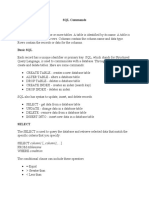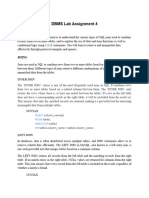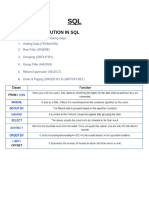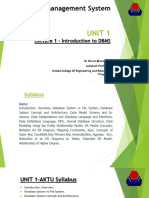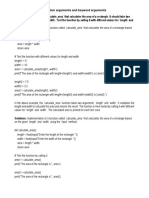SQL-function12
Uploaded by
Mace ChuaSQL-function12
Uploaded by
Mace ChuaAS FUNCTION – Creating an alias name for a column
SELECT column AS new name FROM table;
*Cannot be used in the WHERE and HAVING statement since it will be executed at the end
of the query
*Aggregate functions can be done to the column before renaming the column.
INNER JOIN FUNCTION – Collects and presents data that are present in both tables
SELECT * FROM table 1 INNER JOIN table 2 ON table 1.column name = table 2.column name
*Table order does not matter
*When calling out results, if the column name is not unique the format should be followed
table name.column name
FULL OUTER JOIN FUNCTION – Matches all the data in both tables of the same columns but
places “null” on the data that do not have any match
SELECT * FROM table 1 OUTER JOIN table 2 ON table 1.column name = table 2.column
name
*Table order does not matter
*When calling out results, if the column name is not unique the format should be followed
table name.column name
FULL OUTER JOIN WHERE FUNCTION – Grabs the data that are not present in both columns
SELECT * FROM table 1 OUTER JOIN table 2 ON table 1.column name = table 2.column
name
WHERE table 1.column name IS null OR table 2.column name IS null
LEFT OUTER JOIN – Grabs the data that are present in both table but excludes the data that
is unique to only one table “right”
SELECT * FROM table 1 LEFT OUTER JOIN table 2 ON table 1.column name = table 2.column
name
*Table order does matter since it needs to specify which table is on the “left”
WHERE talbe 2.column name IS null
*Add if the results wanted is exclusive to the data that is unique on the left table
UNION FUNCTION – Gathers the data of both talbes of the same column
SELECT column name FROM table 1 UNION SELECT column name FROM table 2
ADVANCED SQL COMMANDS
SHOW – Displays the setup of the system/computer
TIME AND DATE FUNCTIONS
SELECT CURRENT_TIME
SELECT CURRENT_DATE
SELECT TIMEOFDAY()
SELECT NOW()
EXTRACT FUNCTION – To extract a subcomponent of a date value (Year, Month, Day, Week,
Quarter, DOW [Date of Week])
EXTRACT(SUBCOMPONENT FROM date column)
AGE FUNCTION – Computes the age of a timestamp from the current time/date
AGE(date column)
TO CHARACTER FUNCTION – Generally converts the given input to a character format
TO_CHAR(date column, ‘mm-dd-yyyy’ )
STRING AND OPERATION FUNCTIONS – To create a string of text which can be extracted
from other columns (concatenation), such as making emails from the names of the clients
SELECT column 1 || column 2 FROM table
LEFT AND RIGHT FUNCTION – To grab a certain number of letters from a column
SELECT LEFT(column, number of characters) FROM table;
UPPER AND LOWER FUNCTION – To make the string of characters to be upper or lower
cased
SELECT UPPER(column) FROM table
MATHEMATICAL FUNCTIONS
SUBQUERY – Creating a new query statement inside another query statement using the
parenthesis operation
SELECT column FROM table
WHERE column > (SELECT AVG(column) FROM table )
*The query inside the parenthesis will be computed first
EXIST NOT EXIST FUNCTION – Checks if the rows exists in the in the actual returned
subquery
SELECT column FROM table
WHERE EXISTS (subquery)
SELFJOIN FUNCTION – Connecting information from the same table forming a new table
given the previous table’s information
SELECT table 1.column, table 2.column
FROM table AS table 1
JOIN table AS table 2
ON table 1.column = table 2.column
*All of these tables/data are found in one table, where table 1 and table 2 are just aliases
You might also like
- Class 12 Notes Informatices Pratice Chap 1 (2024-25)No ratings yetClass 12 Notes Informatices Pratice Chap 1 (2024-25)6 pages
- SQL-Commands-revision - Sheet (Nisha - Jha)No ratings yetSQL-Commands-revision - Sheet (Nisha - Jha)1 page
- MYSQL BASIC TO ADVANCE Info For All Types of InterviewsNo ratings yetMYSQL BASIC TO ADVANCE Info For All Types of Interviews25 pages
- ADD Add Constraint Alter: Keyword DescriptionNo ratings yetADD Add Constraint Alter: Keyword Description5 pages
- The SELECT TOP Clause Is Used To Specify The Number of Records To ReturnNo ratings yetThe SELECT TOP Clause Is Used To Specify The Number of Records To Return5 pages
- Question Bank - Module-3 and Module-4 (.5) Key Answers-UpdatedNo ratings yetQuestion Bank - Module-3 and Module-4 (.5) Key Answers-Updated30 pages
- Chapter 2 - SQL Basics and Query OptimizationNo ratings yetChapter 2 - SQL Basics and Query Optimization23 pages
- Quick SQL Cheatsheet: SELECT: Used To Select Data From A DatabaseNo ratings yetQuick SQL Cheatsheet: SELECT: Used To Select Data From A Database8 pages
- Udacity Challenge Prog - DS With Python - NOTESNo ratings yetUdacity Challenge Prog - DS With Python - NOTES84 pages
- (Ebook) Modernizing Enterprise Java: A Concise Cloud Native Guide for Developers (Early Release) by Markus Eisele, Natale Vinto ISBN 9781098102142, 9781098121563, 1098102142, 1098121562 - The ebook is ready for instant download and access100% (2)(Ebook) Modernizing Enterprise Java: A Concise Cloud Native Guide for Developers (Early Release) by Markus Eisele, Natale Vinto ISBN 9781098102142, 9781098121563, 1098102142, 1098121562 - The ebook is ready for instant download and access78 pages
- Core Programming: Basic Object-Oriented Programming in JavaNo ratings yetCore Programming: Basic Object-Oriented Programming in Java25 pages
- Just A Brief Introduction To C++ Data Types PDFNo ratings yetJust A Brief Introduction To C++ Data Types PDF4 pages
- Testbenches - FPGA Designs With VHDL DocumentationNo ratings yetTestbenches - FPGA Designs With VHDL Documentation19 pages
- The Shadow Over Firefox Infiltrate 2015No ratings yetThe Shadow Over Firefox Infiltrate 201566 pages
- Function Arguments and Keyword ArgumentsNo ratings yetFunction Arguments and Keyword Arguments13 pages
- Test Bed For Network Protocols Optimization: Afan Ceco, Member, IEEE, and Sasa Mrdovic, Senior Member, IEEENo ratings yetTest Bed For Network Protocols Optimization: Afan Ceco, Member, IEEE, and Sasa Mrdovic, Senior Member, IEEE6 pages
- Object Oriented Programming Lecture-1: CSE 201 Conducted by Sarwar Morshed Email: Mobile: 01947179930No ratings yetObject Oriented Programming Lecture-1: CSE 201 Conducted by Sarwar Morshed Email: Mobile: 0194717993024 pages
- Lesson Plan: Operators in C ProgrammingNo ratings yetLesson Plan: Operators in C Programming21 pages
- Chapter 1 - Intro To Programming Language 20182019No ratings yetChapter 1 - Intro To Programming Language 2018201954 pages
- Parallel Computing Simply in Depth by Ajit Singh PDFNo ratings yetParallel Computing Simply in Depth by Ajit Singh PDF125 pages
- Segment-6 Discrete Fourier Transform (DFT) & Fast Fourier Transform (FFT)No ratings yetSegment-6 Discrete Fourier Transform (DFT) & Fast Fourier Transform (FFT)32 pages
















